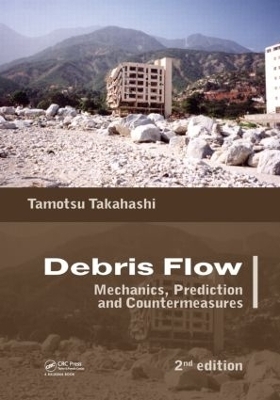
Debris Flow
CRC Press (Verlag)
978-1-138-00007-0 (ISBN)
The qualitative and fundamental character of this text makes it an excellent textbook for graduate-level courses and it is recommended reading for professionals in engineering, geosciences and water resources who are working on the mechanics and countermeasures of debris flow. The original, Japanese version of this book was awarded the ‘Publishing Culture Prize’ by the Japanese Society of Civil Engineers (2004).
Tamotsu Takahashi is Professor Emeritus at the University of Kyoto. In addition to his academic positions, he is the Director of the Association for Disaster Prevention Research in Kyoto. Professor Takahashi began his career in flood dynamics research, and increasingly focused on debris flow and flood hazards. He has been honoured with several awards from the Japan Society of Civil Engineers and the Japan Society of Erosion Control Engineering. An earlier book entitled ‘Debris Flow’, by Tamotsu Takahashi, in the book series of the International Association of Hydraulic Engineering and Research, was published by Balkema Publishers, now a part of the Taylor & Francis Group.
Tamotsu Takahashi (Kyoto, 1939) graduated as a Master in Civil Engineering at Kyoto University in 1965. From 1965 to 1967, he then worked as a research assistant at the Disaster Prevention Research Institute (DPRI) of the same university and, after a year in the Civil Engineering Department as a lecturer, he returned in 1968 to the DPRI as an associate professor. With his research on flood flow dynamics in river channels, he obtained the doctoral degree in 1972. After this, he worked as a post-doctoral fellow at Lincoln College, New Zealand, where he investigated miscellaneous problems that were associated with braided rivers. Upon returning to DPRI in Japan, he put importance on the study of sediment runoff problems that were involved with debris flow and bed load on very steep slope channels. Consequently, in 1982, he was awarded a full professorship for a newly founded research section on the investigation of anti-flood hazards systems. He then added slightly more themes to his portfolio and extended his research to the water flooding and sediment problems in urban areas. From 1992 he moved to the research section on the investigation of sedimentation problems. After his retirement in 2003, he continued working on debris flow and sediment runoff problems as a professor emeritus at Kyoto University. From 1995 to 1997 he served as the director of DPRI and during this appointment, he has reorganized the entire DPRI and has thoroughly promoted the scientific investigation of the Great Hanshin Earthquake which took place in Kobe in 1995 as the director of DPRI and the head of the Japanese Group for the Study of Natural Disaster Science. He is now working for the foundation ‘Association for Disaster Prevention Research’ as the chief director. Professor Takahashi has authored numerous papers and held many invited keynote lectures. He also received several awards for his outstanding work from the Japan Society of Civil Engineers and from the Japan Society of Erosion Control Engineering. His successful book ‘Debris Flow’, published in 1991 by A.A. Balkema Publishers in the IAHR monograph series was the first systematic approach to the subject and is still frequently referred to. The original Japanese language version of this current new and extended edition was received very well and the author was awarded the Publishing Culture Prize from the Japan Society of Civil Engineers in 2004 for it. He was also awarded the Akagi Prize in 2008 for his outstanding contributions to the prevention and mitigation of debris flow disasters.
1. What is debris flow? 2. Models for mechanics of flow 3. Initiation, development and declination of debris flow 4. Characteristics of fully-developed debris flow 5. Processes and geomorphology of deposition 6. Sediment runoff models that include debris flow processes 7. Debris flow disasters and their reproduction by computer simulations 8. Countermeasures for debris flow disasters.
| Erscheint lt. Verlag | 10.3.2014 |
|---|---|
| Zusatzinfo | 19 Tables, black and white; 339 Line drawings, black and white; 35 Halftones, black and white; 374 Illustrations, black and white |
| Verlagsort | London |
| Sprache | englisch |
| Maße | 174 x 246 mm |
| Gewicht | 1308 g |
| Themenwelt | Naturwissenschaften ► Geowissenschaften ► Geologie |
| Naturwissenschaften ► Geowissenschaften ► Geophysik | |
| Technik ► Bauwesen | |
| ISBN-10 | 1-138-00007-8 / 1138000078 |
| ISBN-13 | 978-1-138-00007-0 / 9781138000070 |
| Zustand | Neuware |
| Informationen gemäß Produktsicherheitsverordnung (GPSR) | |
| Haben Sie eine Frage zum Produkt? |
aus dem Bereich


